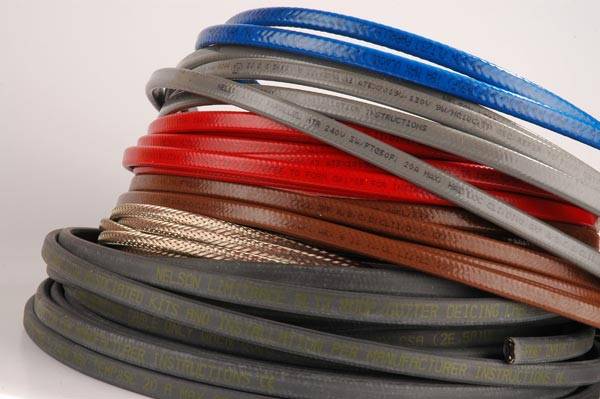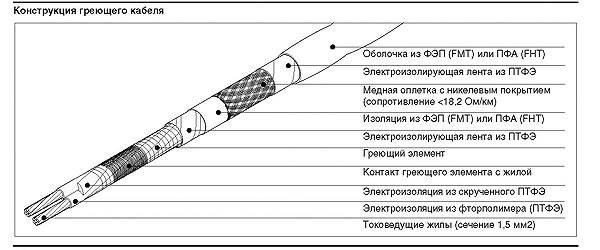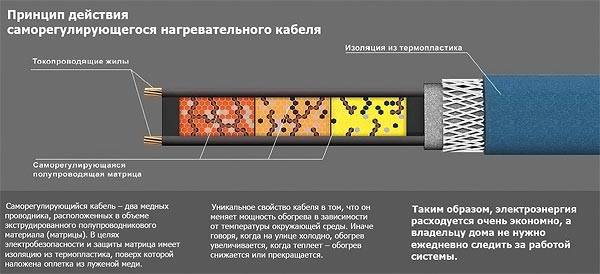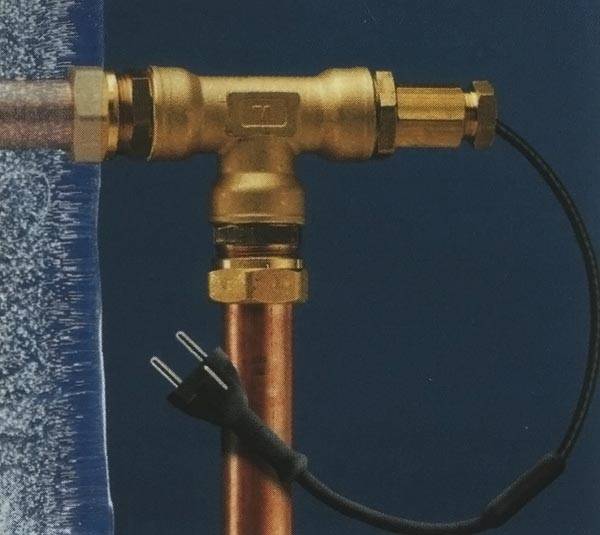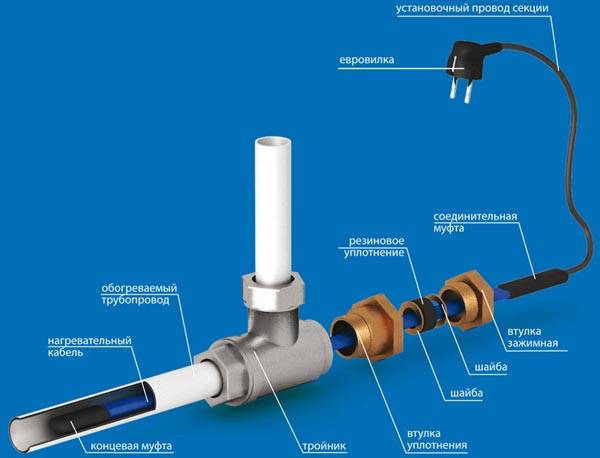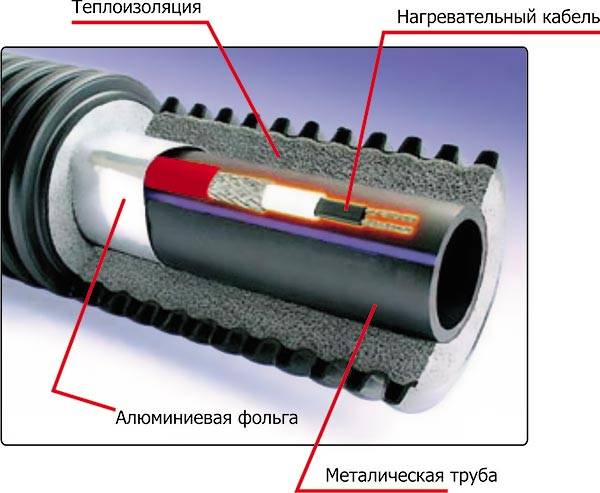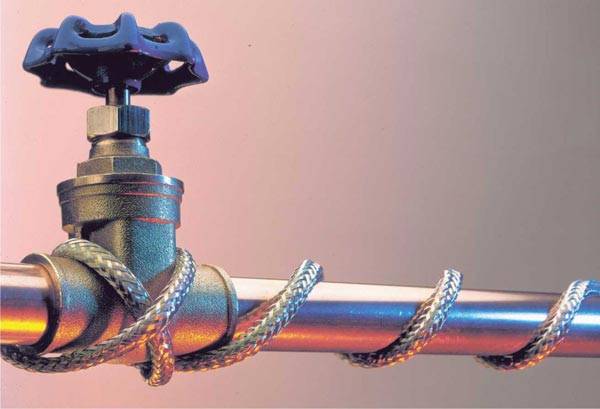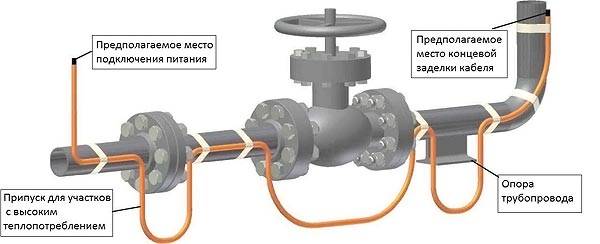Self-regulating heating cable for plumbing
IN every house has places where heating pipes not let down. And if in such cold areas there are water pipes or deep freezing of the soil is observed, and water communications are laid in it, then they simply need to be protected from freezing. The best option that the building materials market provides today is a self-regulating heating cable for a water supply.
The content of the article
What it is?
A self-regulating heating cable for a water supply system is a device that includes a flexible heating source. If you make a dismemberment of it, you can see that plastic thermomass is pressed around the copper veins, which are covered with a tin-copper alloy.
Such wires have the following classification:
- For use in residential buildings. With the help of them, they heat the water supply system and the sewerage system, or rather the pipes of its outlet.
- For commercial heating, i.e. water supply pipes, drainage and fire extinguishing systems.
- For heating industrial points, that is, areas where there is an increased explosion hazard, as well as simple industrial areas.
They may differ in coverage, specificity grounding, as well as its resource of work. The matrix itself "starts up" in operation, which means that it starts to warm up, in the case when it senses a drop in temperature at the installation site. The colder it is, the more heat the matrix gives. The cable is mounted in one of the selected ways and connected to the network via socket... In the case when it is not possible to connect it in this way, you can lead the conductors into the junction box.
The principle of operation of a self-regulating heating cable for a water supply system is to heat pipe sections that are prone to freezing. Its use makes it possible to mount water supply and sewerage systems above the level of soil freezing, which greatly simplifies the work and saves money. The matrix is a heating element that runs along the length of the wire - this allows you to cut it as long as necessary.In addition, such electric cables do not have dead zones, which is found in its "brother" zone cable.
An important feature of such a wire is its ability to self-regulate. It is clearly manifested in the following situation. When a water supply system is laid, part of it can pass along the surface of the earth, part over a freezing area of soil, and part under it. But in order to exclude freezing, it is better to mount the electric cable along its entire length, but the temperature of the pipe, to which the cable reacts, will be different. Here self-regulation comes into play - the device itself will determine where what temperature is needed for an optimal state and this is its important advantage.
Video: aboutheating water pipes with a heating cable
How to choose the right one?
Before choosing an energy cable for heating pipes with self-regulation, you need to know the following parameters:
- The diameter of the pipe and what material it is made of.
- What is the thickness of the insulation.
- What percentage of heat loss occurs in the pipe and how much energy is needed to shut it off.
To increase the effect, the entire system needs insulation, and it must also be chosen correctly. The correct solution to this issue will help to reduce heat loss and more economically use up the heating potential, which means to extend its life. The required thickness of insulation will depend on the thickness of the pipe, below are the recommended parameters.
| Pipe diameter, inches - mm | Minimum insulation thickness,mm |
| 1/2 – 15 | 20 |
| 3/4 – 20 | 20 |
| 1 – 25 | 30 |
| 1 ¼ — 32 | 30 |
| 1 ½ — 40 | 40 |
| 2 – 50 | 50 |
| 2 ½ — 65 | 65 |
Installation inside
A self-regulating heating cable for a water supply system inside a pipe is allowed to be laid in case of freezing of a system that is already functioning. Particular attention should be paid to its installation when used with drinking water. The power cord must be of the correct type that allows it to be used in this case. This means that his shell has been tested appropriately.
In order to enter the cable into the system, it is necessary to use an oil seal. During installation, you must be guided by the following rules:
- When approaching from above, additional fixation is not required. The opposite cannot be said. In order to prevent it from "crawling" from the inside, it is necessary to fix it well.
- Before installing it in the pipe cavity, you need to measure the required length.
- Do not lay the wire in areas with taps and other shut-off valves. After installation, it is necessary to make a corresponding note that the pipeline is heated.
- When inserting the electrical cord inside, care must be taken not to damage its outer sheath. For this, all potentially dangerous places must be covered with tape.
Upon completion of the laying, a plug is connected to the wires of the wire or included in the nearest junction box.
External way
If the pipes are only laid or lie shallow and there is a possibility of laying the cable on top, then there are different options for its placement on the pipe and other components of the pipeline, namely:
- Parallel to the pipe. There may be variations; in case of severe freezing, it is advisable to lay 2 or more cables, which should be placed in parallel.
- Spiral cable winding of the pipe.
- Laying the cable in a wavy line, there may also be variations.
- There are different options for laying the cable and near the valve, on elbows, flanges, and other areas.
General rules for outdoor installation:
- It is important to control the installation process for the absence of mechanical damage to the cable, including compression, chafing, stretching.
- Fasten the cable to the pipe tightly and secure it with aluminum tape.To begin with, use small pieces for fastening, and then gluing is carried out over all areas. In this case, it is possible to achieve the exclusion of contact of the cable with the thermal insulation, the reliability of attachment to the pipe and a large area of heat transfer.
- Do not use plastic straps for fastening.
- If the pipes are plastic, then it is better to pre-glue them with aluminum tape.
conclusions
The use of an additional source of heat, which guarantees the availability of water in the house and the work of the sewer, is very helpful at low temperatures. Modern technologies make it possible to use a self-regulating heating cable for a water supply, the principle of which is to heat the pipe and its components when the temperature drops. The cable itself knows how much needs to be heated, so all you need to do is to carry out the installation correctly and enjoy the benefits of its work.
Video: installation of a self-regulating heating cable inside the pipe



